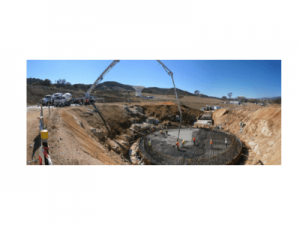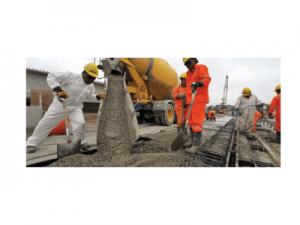Table of Contents
What is RMC?
As the name indicates, Ready Mixed Concrete (RMC) is the concrete that is delivered in a ready-to-use manner. RMC is defined by the American Concrete Institute’s Committee 116R-90 as “Concrete that is manufactured for delivery to a purchaser in a plastic and unhardened state”.

Readymix concrete is concrete produced in a batch plant following the design of a set of engineered mixes. Concrete Readymix is normally supplied in two ways. First is the truck barrel or mixer in-transit. This type of truck provides the site with concrete in a plastic state.
Ready-mix concrete (RMC) is a type of concrete manufactured in a cement factory, or specifically known as the batching plant, according to a given set of proportions, and then delivered by truck mounted with mixers to a work site. This outcome is an accurate blend that allows the development and implementation of specialist concrete mixtures on building locations. The glove plant that manufactured ready mix concrete was constructed in the 1930s, but not until the early 80s did the sector start to grow. It has continued to grow substantially since then.
Ready-mix concrete is sometimes preferred over on-site concrete mixing because of the volume it can produce with the precision of the proportion of mixtures and also due to reduced work site confusion. Using a pre-determined concrete mixture reduces flexibility, both in the supply chain and in the actual components of the concrete.
Ready-mix concrete is also called for business purposes as tailored concrete products. Ready-mix concrete (RMC) refers to concrete specifically produced in a freshly mixed and plastic or unhardened state for delivery to the customer’s construction site. Concrete it is a mixture of sand and gravel or crushed stone from Portland cement, water and aggregates. Each of these components is procured individually at traditional job locations and blended at the plant in defined ratios to create cement. Ready-mix concrete is purchased and sold by volume, usually expressed in cubic meters (cubic yards in the United States).
Ready-mix concrete is produced under-regulated activities and used advanced machinery and techniques are transferred and put on location. In 2011, 72,924 workers were employed in 2,223 companies in the United States that produced Ready Mix Concrete.

Contents:
- Process
- Advantages
- Disadvantages
- Volumetric Mixer
Process of Ready-Mix Concrete
Ready-mix concrete contains cement, aggregates, sand, water and other chemicals that are batched for special value at a remotely situated plant. The concrete is then delivered in transit mixers to the construction site and can be used immediately without further processing. The automatic plant monitors weigh-batching, water-cement ratio, admixture dosage, moisture content, accurately producing concrete of quality.
All components used to prepare ready mix concrete are carefully checked in a well-equipped laboratory connected to the plant for compliance with appropriate international standard standards for their performance and physical characteristics. The moisture test determines the sand and aggregates water content. This, therefore, helps to fix the amount of water to be added to prepare the mix. Trial mixes are performed and tested to ensure that every batch of concrete coming out of the plant meets different mixing designs as required by the customer with different concrete grades.
Following are the Advantages of Ready-Mix Concrete
- Production of RMC is relatively pollution-free
- RMC reduces the labor cost and site supervising cost
- Reduced project time resulting in savings in all aspects
- Production of RMC helps in minimizing cement wastage due to bulk handling
- Proper control and economy in the use of raw material resulting in the saving of natural resources
- Ready Mix Concrete (RMC) allows speedy construction through programmed delivery at site, mechanized operation with the consequent economy
- RMC comes with consistency in quality through accurate & computerized control of sand aggregates and water as per mix designs.
Disadvantages of Ready-Mix Concrete
- At a key plant, the components are batched and the mixing starts at that very plant. So it is critical to travel time from the plant to the site over longer distances. Some sites are just too far away, which can risk being unusable due to the setting of ready mix concrete.
- It will produce more vehicles on the highway. Ready Mix Trucks are generally large and can cover a lot of road area that blocks other traffic. Also, access roads and access to the site must be able to carry the higher ready-mix truck weight plus load. (Green concrete is approx. 2.5 tons per m3.) This problem can be overcome by using so-called’ mini mix ‘ firms using smaller 4m3 capacity mixers that can reach more restricted sites.
- The limited-time period between mixing and curing of concrete means that ready-mixing should be placed at the plant within 210 minutes of batching. However, the amount and type of admixture added to the mix is very important, modern admixtures can modify that period precisely.
Volumetric Mobile Mixer
A portable volumetric mixer can provide a nice solution to concrete ready-mix. This is a hybrid approach between on-site mixing and ready-mix concrete. The volumetric mobile mixer is a truck containing concrete ingredient materials and water to be mixed on the truck at the worksite to make and deliver concrete as required. At the job site, on-truck mixing eliminates the issues of ready-mix concrete such as errors that can make the pre-mixed concrete unusable.
